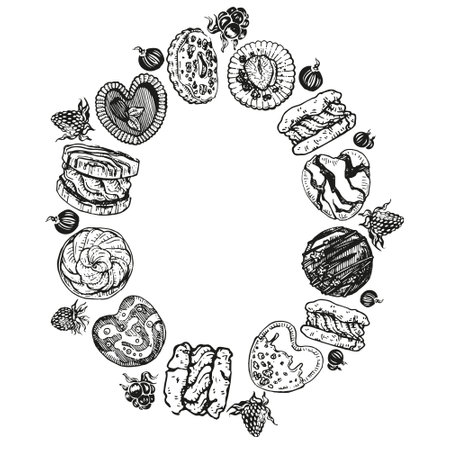The Essence of British Cuisine
British cuisine, deeply rooted in centuries-old traditions, is a testament to the nation’s rich history and diverse landscape. From the rolling hills of Yorkshire to the rugged coastlines of Cornwall, local ingredients have always played a pivotal role in shaping the country’s culinary identity. The story of British food is not merely about sustenance but also about community, heritage, and adaptation. Throughout history, iconic meals such as roast dinners, fish and chips, and shepherd’s pie have evolved in response to changing agricultural practices, trade links, and social hierarchies. These dishes reflect both the resourcefulness of British cooks and the significance of mealtimes as communal rituals. Today, traditional British fare continues to embody the spirit of its people: hearty, comforting, and imbued with symbolic meanings that resonate from one generation to the next.
2. Full English Breakfast: More Than a Meal
The Full English Breakfast is not merely a culinary tradition—it is a cultural institution woven into the fabric of British daily life and identity. This iconic meal, often simply referred to as a “fry-up,” transcends its role as sustenance to symbolise hospitality, comfort, and the enduring importance of morning rituals within British society.
Components of a Full English Breakfast
A traditional Full English Breakfast is celebrated for its hearty and diverse selection of ingredients. While regional variations exist, the essential components are consistent across the country:
| Component | Description | Symbolic Meaning |
|---|---|---|
| Bacon | Crispy or back bacon slices | Warmth & tradition |
| Sausages | Pork sausages, sometimes local specialities | Community & regional pride |
| Eggs | Fried, scrambled, or poached | New beginnings & potential |
| Baked beans | Hearty beans in tomato sauce | Sustenance & comfort |
| Tomatoes | Grilled or fried halves | Vitality & balance |
| Mushrooms | Sautéed mushrooms | Nourishment from nature |
| Black pudding | Sliced blood sausage (optional) | Heritage & resilience |
| Toast or fried bread | Slices of bread toasted or fried in oil/butter | Foundation & stability |
Cultural Significance and Symbolism
The ritual of preparing and sharing a Full English Breakfast extends far beyond nutritional value. For many Britons, it represents:
- A sense of belonging: Whether enjoyed at home, in a bustling café, or at a local bed and breakfast, this meal fosters community ties and shared traditions.
- An emblem of hospitality: Offering a fry-up to guests is seen as an act of generosity and welcome.
- A symbol of perseverance: The robust nature of the meal mirrors the British spirit—resilient and ready to face the day.
- An anchor for morning rituals: The process of preparing and consuming this breakfast is often steeped in routine and mindfulness, grounding individuals before their daily activities.
The Role in Food Dreams and British Identity
Within the context of food dreams, the Full English Breakfast can be interpreted as a desire for comfort, security, and continuity amidst change. The symbolic elements—such as eggs representing new opportunities or toast signifying stability—reflect deeper yearnings present within the collective British psyche. Thus, dreaming of this meal may indicate both nostalgia for communal experiences and optimism for what lies ahead.
A Lasting Ritual Amidst Modernity
Despite shifts towards convenience foods and global influences on the British diet, the Full English Breakfast endures as a cherished morning ritual—a testament to its rich symbolism and ongoing relevance in contemporary British culture.

3. Sunday Roast: Family, Community, and Ritual
Among all traditional British meals, the Sunday roast stands out as an enduring symbol of unity and continuity. This meal is not merely about roasted meats and seasonal vegetables; it encapsulates the core values of family togetherness, community bonding, and the comfort of shared rituals. The origins of the Sunday roast date back to the post-medieval era, when families would place a joint of meat in the oven before heading to church, returning home to a hearty meal that signified both rest and reward after a week’s labour. Over centuries, this tradition has evolved but retained its central role in British culture.
The Heartbeat of Home Life
The Sunday roast acts as a weekly anchor in many households across the UK. It is more than just sustenance; it is an event that draws people around the table, encouraging conversation and connection. In British food dreams, the aroma of roasting beef or chicken often conjures feelings of nostalgia and security, linking individuals to their childhoods and wider family histories. Such associations highlight how food can function as a repository for collective memory.
Symbolism Beyond the Plate
On a symbolic level, the ritual of sharing a roast represents generosity, hospitality, and inclusivity. Traditionally served with Yorkshire puddings, roast potatoes, and lashings of gravy, every element on the plate carries significance—each addition reflects regional preferences and familial customs. The act of carving meat at the table often falls to the head of the household, reinforcing social roles and offering a moment for gratitude and celebration.
A Tradition Rooted in Community
Historically, public houses or local inns would also serve communal roasts on Sundays, strengthening neighbourhood ties. Today, while dining habits have diversified, many Britons still uphold this custom in some form, whether at home or in gastropubs. The Sunday roast thus persists as both a personal comfort and a societal glue—a culinary practice that bridges generations and preserves British identity through shared experience.
4. Afternoon Tea: Class, Elegance, and Ritual
Afternoon tea holds a unique place in British culture, not merely as a meal but as an enduring symbol of social refinement and tradition. Originating in the early 19th century, this ritual was popularised by Anna, the Duchess of Bedford, who sought to bridge the gap between lunch and dinner with a light meal accompanied by tea. Over time, afternoon tea evolved into a mark of sophistication, particularly among the upper classes, embodying values of civility, gentility, and hospitality.
The Heritage and Symbolism of Afternoon Tea
Historically, afternoon tea was more than just a culinary interlude; it was an event that showcased elegance and social hierarchy. Invitations to partake in afternoon tea were considered prestigious, allowing hosts to display their taste through fine china, delicate linens, and carefully curated menus. This tradition reinforced distinctions between classes while providing an opportunity for socialising in a controlled, refined setting.
The Role of Key Treats: Cakes, Scones, and Sandwiches
The elements served during afternoon tea are themselves laden with symbolic meanings. Each item on the tiered stand reflects British culinary heritage and societal values:
| Item | Symbolic Meaning | Cultural Context |
|---|---|---|
| Finger Sandwiches | Simplicity & Sophistication | Represents restraint and elegance; fillings like cucumber or smoked salmon highlight subtlety over excess. |
| Scones with Clotted Cream & Jam | Tradition & Regional Pride | Debates over “cream first” (Devon) or “jam first” (Cornwall) illustrate local identities within the national tradition. |
| Cakes (e.g., Victoria sponge) | Celebration & Indulgence | Nods to royal history and the joy of sharing sweet treats as part of communal experience. |
Afternoon Tea in Contemporary British Society
In modern Britain, afternoon tea continues to serve as both a nostalgic ritual and a marker of occasion—often reserved for celebrations or special gatherings. Its persistence highlights how food-related traditions can preserve cultural identity while also adapting to new social contexts. The symbolism embedded in afternoon tea—from class distinction to the pleasure of shared indulgence—underscores its role as more than just sustenance; it is a living testament to British values of civility, hospitality, and understated luxury.
5. Fish and Chips: A National Icon
Analysing the Rise of Fish and Chips as a British Staple
Fish and chips emerged in the late 19th century, coinciding with rapid industrialisation and urbanisation in Britain. The combination of deep-fried fish and golden chips was both affordable and filling, making it an instant favourite among the working class. Its popularity quickly spread across cities like London and Manchester, where factories and mills shaped daily life. The simplicity of preparation, coupled with the accessibility of ingredients due to advances in fishing technology and railway networks, propelled fish and chips from street stalls to high street shops. Over time, this humble meal became synonymous with British culinary identity.
Representation of Urban Working-Class Culture
Fish and chips is more than just a dish; it represents the spirit of Britains urban working class. During periods of economic hardship, such as the World Wars, fish and chips remained one of the few foods not subject to rationing, further cementing its place in the national psyche. It became a symbol of comfort, resilience, and solidarity for communities facing uncertainty. The communal aspect of eating fish and chips—often wrapped in newspaper and enjoyed outdoors or on the way home—echoes values of simplicity, resourcefulness, and togetherness prevalent in working-class neighbourhoods.
Ongoing Legacy in Modern Britain
Today, fish and chips endures as a cherished tradition within British food culture. Despite evolving tastes and the influx of global cuisines, this classic meal continues to be celebrated at seaside resorts, local chippies, and family gatherings alike. Its enduring appeal lies in its ability to evoke nostalgia while adapting to contemporary sensibilities—offering gluten-free batter options or sustainably sourced fish, for example. Symbolically, fish and chips serves as a culinary bridge between past and present, reminding Britons of their shared heritage while reinforcing cultural values rooted in community spirit and perseverance.
6. Puddings and Pasties: Sweet and Savoury Symbols
In the rich tapestry of British cuisine, puddings and pasties stand as both culinary delights and powerful cultural symbols. These dishes, whether sweet or savoury, are woven into the fabric of daily life and special occasions across the UK. To understand their significance is to glimpse the collective dreams, comforts, and regional pride that shape the British food identity.
The Comfort of Tradition: Shepherd’s Pie and Beyond
Shepherd’s pie—a warm blend of minced lamb, vegetables, and a golden layer of mashed potato—epitomises the British notion of comfort food. Its roots trace back to humble beginnings, where resourcefulness turned leftovers into hearty meals. Today, shepherd’s pie remains a staple in many homes, symbolising not just nourishment but also familial love and resilience through generations. Similar dishes, such as cottage pie or Cornish pasty, echo this tradition of transforming simple ingredients into meals that evoke warmth and belonging.
Sweets with Stories: Sticky Toffee Pudding
No exploration of British puddings would be complete without sticky toffee pudding. This indulgent dessert—soft sponge cake soaked in rich toffee sauce—holds an iconic status on pub menus nationwide. The ritual of sharing pudding at the end of a meal encapsulates togetherness and celebration. Moreover, regional variations like Bakewell tart or Eton mess reflect local histories and pride, connecting people to their roots through flavourful traditions.
Pride in Place: Regional Specialities
Across Britain, every region boasts its own beloved pastry or pudding. From the hearty Cornish pasty in the southwest to Yorkshire’s parkin cake in the north, these dishes serve as edible emblems of local culture. They are often centrepieces at festivals or family gatherings, reinforcing community bonds and highlighting regional diversity within the national food landscape.
Symbolism on Every Plate
Ultimately, classic British puddings and pasties offer more than sustenance—they are expressions of memory, heritage, and hope. Whether enjoyed at Sunday lunch or passed around during festive celebrations, these foods capture the essence of what it means to belong. Through them, Britons keep alive stories of hardship overcome, joys shared, and a collective dream for comfort amid life’s uncertainties.


